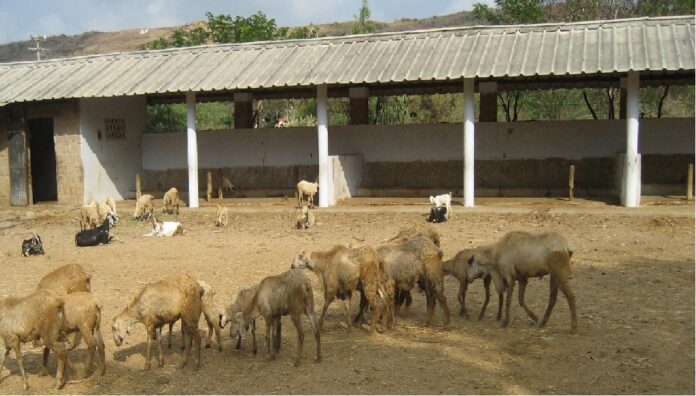SHEEP HUSBANDRY PRACTICES IN INDIA
Sheep Husbandry or sheep farming contributes significantly not only to numbers but also to sustainable livelihood options in the country. It has been observed in recent days that the sheep population has increased in the areas of Telangana, Andhra Pradesh, and Karnataka (Table 1), where farmer suicides due to crop failure were more. Sheep are the lifeline in areas where crop failure is commonplace and the rural population, NGOs, and also government is realizing the importance of this species in sustaining their livelihood. According to the 20th livestock censusby India’s Department of Animal husbandry and Dairying (DAHD) (2019), Telangana ranks first in sheep population with nearly 25.72% sheep population followed by Andhra Pradesh (23.70%) and Karnataka (14.95%). Large ruminants are specifically reared for milk production in our country and therefore they are out of production for a significant part of their life. However, sheep are such an animal that isa true sense act as a security option and remain always ready for cash option with the farmer. Utilizing sheep husbandry as a livelihood security option in arid and semi-arid regions of India can be tried to minimize dependency on rain-fed crops.
Small ruminants (sheep and goats) play a significant role in the socio-economic and cultural livelihood of the rural folk in India. It provides livelihood to two-thirds of the rural community.The rural population constitutes 72.22% out of which the majority are dependent directly orindirectlyon agricultureand livestock-related occupations. According to the 20th livestock census (2019), species-wise out of total livestock available in the country, around 36.04% are cattle, 27.74% are goat, 20.74% are buffaloes, 13.83% are sheep and 1.69% are pigs. All other species of livestock are less than 0.23% of the total livestock. The small ruminants suites the need forthe small landholder and village system due to low initial investment, ease of rearing, and high feed conversion efficiency. Besides this, they are very well adapted to the harsh climate, long migration, resistance to tropical diseases, poor nutrition, and shortage of drinking water and water quality. Sheep with multi-facet utility (for meat, wool, skin, manure, and to some extent milk) play a vital role in the Indian agrarian economy. They are better adapted to arid and semi-arid tropics with marginal and sub-marginal lands. They are perhaps the most suitable small ruminants to utilize the sparse vegetation available in dryland areas through rangeland management and reseeded pastures (Adegbeye et al., 2020). Sheep farming is important source of livelihood in various parts of underdeveloped or developing world viz. steppe (Inal et al., 2021), Chiapas, Mexico (Rebello-Morales et al., 2021), North Caucasus (Gogav et al., 2021) and Algeria (Merrouchi et al., 2021). According to the Food and Agriculture Organization Corporate Statistical Database (FAOSTAT) (2019) database of the United Nations Food and Agriculture Organization, the top three countries by the number of heads of sheep were: Mainland China (163.48 million heads), India (74.26 million) and Australia (65.75 million). India ranks second in sheep population and accounts for more than 4.03% of the world population (FAOSTAT, 2019) with 74.26 million sheep to its record. In India from post-independence 1951 (39.10 million) till the 2019 livestock census (74.26 million) the sheep population increased by 89 %. Sheep husbandry or sheep farming is the backbone of the rural economy in India. Indigenous sheep contribute greatly to the agrarian economy, especially in areas where crop and dairy farming are not economical and play an important role in the livelihood of a large proportion of small and marginal farmers and landless laborers. Sheep were developed following domestication and natural and human selection over the past 12,000 years. They provide a dependable source of income to the animal owners. According to the FAO World Watch List (2000), there are 60 breeds of sheep in India. This list includes both well recognized and lesser-known breeds along with some wild species and according to the National Bureau of Animal Genetic Resources NBAGR (2021), details of 44 distinguished sheep breeds are available. These sheep breeds are well adapted to specific agroclimatic regions of the country. The current number of breeds of sheep is likely an underestimation as a large proportion of indigenous livestock populations in developing countries including India, are yet to be described at phenotypic and genetic levels. Genetic diversity signifies a unique resource to respond to the present and future needs of sheep production and human needs.
Compiled & Shared by- This paper is a compilation of groupwork provided by the
Team, LITD (Livestock Institute of Training & Development)
Image-Courtesy-Google
Reference-On Request.
SHEEP HUSBANDRY PRACTICES IN INDIA
SHEEP HUSBANDRY PRACTICES IN INDIA
Common factors that affect the quality of wool harvest from sheep




